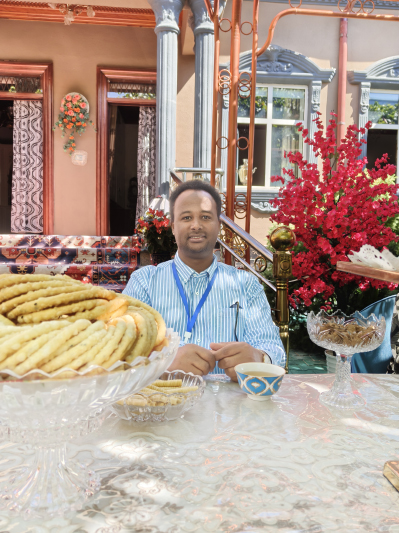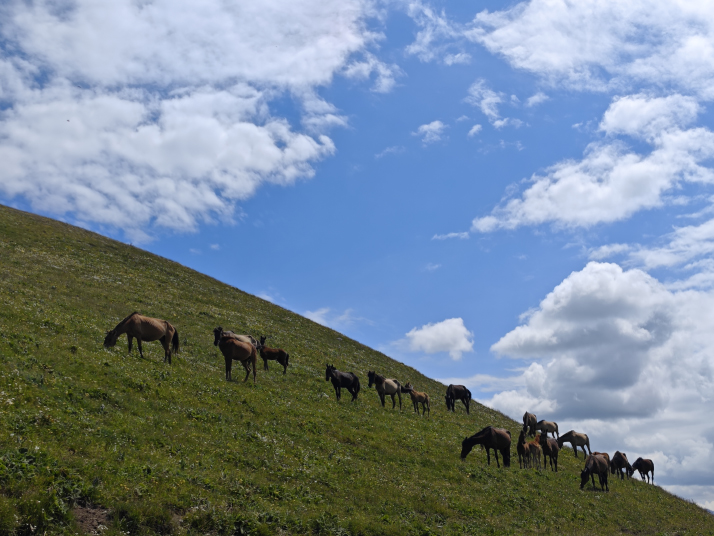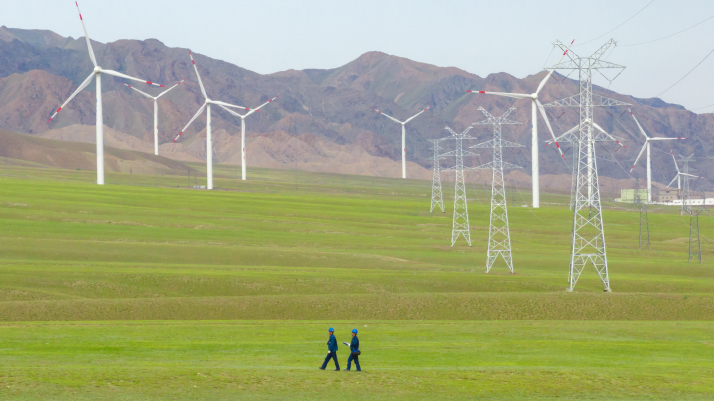| Xinjiang Today |
| A mosaic of cultures | |
|
|
 The author enjoys local cuisine in a village in Yining City, Ili Kazak Autonomous Prefecture, on August 27 (COURTESY PHOTO)
Xinjiang had always been in my imagination, a land whispered about in stories and celebrated in songs and with photographs so vivid they seemed unreal. Its beauty seemed distant and almost mythical, and I carried this longing with me for years to go there. So when the opportunity arose to travel there on a weeklong study tour, I seized it without hesitation.
What I didn't expect was how deeply the real Xinjiang would move me, how it would not only meet but exceed all my expectations. From its breathtaking landscapes to its rich cultural traditions, from time-honored customs to signs of modern progress, Xinjiang captivates with a charm that is unique. From the moment we arrived, I felt time stretch. In Bole or Bortala, a steppe city in north Xinjiang that was our first stop, evening light lingered well into the night, as though the sun too was reluctant to leave. There was a golden hour that seemed to last for ages, casting a honeyed glow on everything. Though we had no formal plans that night, I couldn't bear to stay inside. With a childlike urgency, I dropped my bags and set off into the soft light, pulled by the hum of music and laughter drifting from a nearby park. There, people danced with a grace that seemed both practiced and spontaneous. Strangers waved and smiled, drawing me into conversations I hadn't expected. One man invited me to his home, insisting I shouldn't stay in a hotel. "You are our guest," he said with a warmth that transcended language. It was my first night in Xinjiang, and already the land had begun to reveal its spirit, generous, joyful and unafraid to connect. He became my first friend in Xinjiang.  The Kalajun Grassland in Ili Kazak Autonomous Prefecture in June 2024 (VCG)
As we journeyed deeper into the region, landscapes unfolded that seemed sculpted from dreams. Vineyards stretched in quiet abundance, their fruit impossibly sweet, kissed by the sun and time. I wandered through rows of grapes and fruit trees, tasting the labor and care of the people who tended them. There was a quiet pride in their voices as they spoke of their land, not boastful, but rooted in belonging. We passed through places where lakes shimmered like glass and small villages nestled against vast backdrops of desert and mountain. One afternoon, I found myself in an open-air hot spring. It was in Zhalemute a township in Bortala Mongolian Autonomous Prefecture, surrounded by silence so complete it felt sacred. The sky above was endless, and as I looked up through the rising steam, I felt momentarily suspended between earth and heaven, as though the boundaries between body and landscape had blurred. It was this feeling of being held within something larger than myself that defined much of the trip. Standing on the shore of Sayram Lake, Xinjiang's highest and largest alpine lake, I felt it again. The water was impossibly clear, the stones beneath visible as if under glass. Snow-capped mountains rose in the distance, their reflection dissolving into the lake, creating an illusion where sky and water became indistinguishable. In that stillness, I walked the lake's edge, and with each step, the clutter of daily life, worries, deadlines and obligations fell away. But Xinjiang is not only a place of stunning geography. It is a living mosaic of cultures, languages and traditions, all woven together in vibrant coexistence. In the Kalajun Grassland in the Ili River Valley, an important part of the UNESCO-recognized Xinjiang Tianshan World Natural Heritage site, I saw herds of horses grazing freely, their movements serene against the open plains. Though I longed to ride, the way I had once imagined as a child watching Chinese martial arts films, I remained a quiet observer, rocked gently in a horse-drawn carriage as the vastness of the land passed by. Even so, something in me galloped alongside them, an old dream reawakened.  Technicians patrol power transmission facilities near the Sayram Lake on July 17 (XINHUA)
We returned to the city in the final days, but the magic did not fade. Through the bus window, I watched the Tianshan Mountains stretch across the horizon, their snowy peaks glowing under the sun. The Gobi Desert sparkled beside them, its sands flecked with hardy camelthorn shrubs. Entering the city felt like a return to reality, yet Xinjiang's pulse remained—louder now, clearer. The streets bustled with life, lined with trees with blooming flowers. Shops overflowed with goods, and people wore traditional garments in bright, celebratory colors. Once again, hospitality greeted me at every turn. Invited into a local home, I was met with a spread of Xinjiang cuisine so rich and generous it felt ceremonial. I wasn't a tourist. I was a guest. I was family. One of the most profound moments came in the Ili Prefecture Museum, where ancient artifacts and historical documents told the story of Xinjiang, not as a remote frontier, but as an inseparable part of China's shared history. Here was a place where cultures had intertwined for centuries, where diversity had not divided, but nourished something greater. I saw, with clarity, that Xinjiang is not simply beautiful. It is vital. Returning to Beijing, I carried with me more than just photographs and memories. I returned with a sense of having touched something essential, something rooted in history and yet reaching forward with energy and promise. Xinjiang is vast, and we barely skimmed its surface. But even that brief encounter was enough to transform me. This journey was not just travel. It was revelation. It showed me a real, radiant, complex Xinjiang, and in doing so, deepened my understanding of the country I call home now. I hope that more people will venture there, not only to see its beauty but to feel its heartbeat. In Xinjiang, I discovered not just a land of wonder, but a mirror reflecting humanity at its finest—diverse, interconnected and endlessly resilient. I hope more people will journey there to experience its remarkable spirit for themselves. The author is a Somali sinologist who works in the School of African Studies, Beijing Foreign Studies University Comments to zhaowei@cicgamericas.com |
|
||||||||||||||||||||||||||||
|